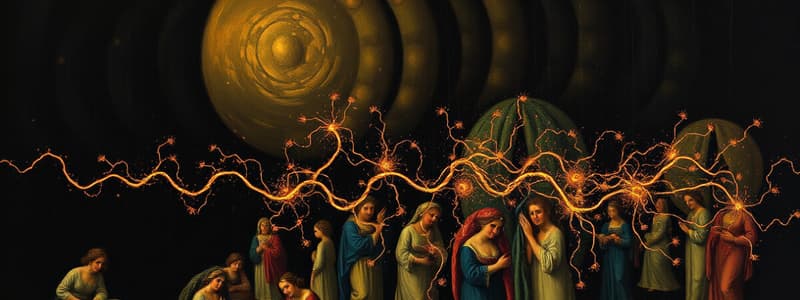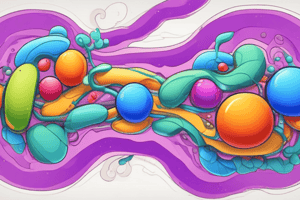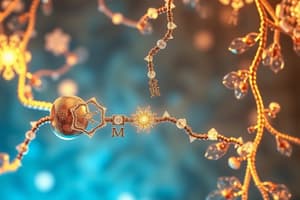Podcast
Questions and Answers
What is the primary role of NADH dehydrogenase in the electron transport chain?
What is the primary role of NADH dehydrogenase in the electron transport chain?
- To convert ubiquinone to FMNH2
- To accept protons from the mitochondrial matrix
- To transfer electrons from NADH to ubiquinone (correct)
- To produce ATP directly
Which of the following describes coenzyme Q?
Which of the following describes coenzyme Q?
- An enzyme that catalyzes ATP formation
- A lipid-soluble electron carrier with a long isoprenoid tail (correct)
- A type of cytochrome involved in ATP synthesis
- A proton pump embedded in the mitochondrial membrane
How does the iron in cytochromes function within the electron transport chain?
How does the iron in cytochromes function within the electron transport chain?
- It is reversibly converted between ferric and ferrous states (correct)
- It is involved in the synthesis of NADH
- It catalyzes the reaction of ADP to ATP
- It binds to oxygen permanently
What forms after NADH is oxidized by NADH dehydrogenase?
What forms after NADH is oxidized by NADH dehydrogenase?
What component is NOT part of the electron transport chain discussed?
What component is NOT part of the electron transport chain discussed?
Which structure within NADH dehydrogenase is essential for transferring hydrogen atoms?
Which structure within NADH dehydrogenase is essential for transferring hydrogen atoms?
Which option accurately describes the conversion of cytochrome iron during electron transport?
Which option accurately describes the conversion of cytochrome iron during electron transport?
Where does coenzyme Q get its hydrogen atoms from?
Where does coenzyme Q get its hydrogen atoms from?
Which enzyme complex is directly involved in the oxidation of succinate?
Which enzyme complex is directly involved in the oxidation of succinate?
What is the primary function of cytochrome a + a3 within the electron transport chain?
What is the primary function of cytochrome a + a3 within the electron transport chain?
How do site-specific inhibitors affect the electron transport chain?
How do site-specific inhibitors affect the electron transport chain?
What occurs to electron carriers located before a site-specific inhibitor?
What occurs to electron carriers located before a site-specific inhibitor?
What type of reaction is always associated with oxidation in redox pairs?
What type of reaction is always associated with oxidation in redox pairs?
What is the role of standard reduction potential (E°) in redox pairs?
What is the role of standard reduction potential (E°) in redox pairs?
Which molecule acts as an electron acceptor in the electron transport chain?
Which molecule acts as an electron acceptor in the electron transport chain?
What happens to electrons as they move through the electron transport chain?
What happens to electrons as they move through the electron transport chain?
What forms when cytochrome a + a3 reacts with molecular oxygen?
What forms when cytochrome a + a3 reacts with molecular oxygen?
What does NAD+ gain during a redox reaction?
What does NAD+ gain during a redox reaction?
Which of the following statements about electron transport is true?
Which of the following statements about electron transport is true?
What is the primary function of the inner mitochondrial membrane?
What is the primary function of the inner mitochondrial membrane?
What are the structures called that increase the surface area of the inner mitochondrial membrane?
What are the structures called that increase the surface area of the inner mitochondrial membrane?
Which complex in the inner mitochondrial membrane catalyzes ATP synthesis?
Which complex in the inner mitochondrial membrane catalyzes ATP synthesis?
What role do dehydrogenases play in the formation of NADH?
What role do dehydrogenases play in the formation of NADH?
Which component is NOT part of the electron transport chain?
Which component is NOT part of the electron transport chain?
Which redox pair has the most positive standard reduction potential (E°)?
Which redox pair has the most positive standard reduction potential (E°)?
Which protein carrier accepts electrons from electron donors in the electron transport chain?
Which protein carrier accepts electrons from electron donors in the electron transport chain?
What is the standard free energy change (ΔG°) when one electron is transferred from NADH to cytochrome c?
What is the standard free energy change (ΔG°) when one electron is transferred from NADH to cytochrome c?
What approximately composes fifty percent of the mitochondrial matrix?
What approximately composes fifty percent of the mitochondrial matrix?
How many ATP can be produced from the transport of electrons from NADH to oxygen?
How many ATP can be produced from the transport of electrons from NADH to oxygen?
What are the protruding spheres attached to the inner membrane known as?
What are the protruding spheres attached to the inner membrane known as?
What does the chemiosmotic hypothesis primarily describe?
What does the chemiosmotic hypothesis primarily describe?
What metal is commonly involved in the electron transport chain proteins?
What metal is commonly involved in the electron transport chain proteins?
Which compound is a strong reducing agent from the provided standard reduction potentials?
Which compound is a strong reducing agent from the provided standard reduction potentials?
What is the Faraday constant (F) value used in calculating ΔG°?
What is the Faraday constant (F) value used in calculating ΔG°?
What is the primary byproduct of oxygen's role in the electron transport chain?
What is the primary byproduct of oxygen's role in the electron transport chain?
What is formed when metabolic intermediates donate electrons to NAD+ and FAD?
What is formed when metabolic intermediates donate electrons to NAD+ and FAD?
Where is the electron transport chain located within the mitochondrion?
Where is the electron transport chain located within the mitochondrion?
What role does the electron transport chain play in ATP production?
What role does the electron transport chain play in ATP production?
Which complex in the electron transport chain accepts electrons from NADH?
Which complex in the electron transport chain accepts electrons from NADH?
What is the end product of the electron transport chain when electrons are transferred to oxygen?
What is the end product of the electron transport chain when electrons are transferred to oxygen?
How does the movement of electrons through the electron transport chain affect free energy?
How does the movement of electrons through the electron transport chain affect free energy?
What is the coupling process associated with ATP synthesis in oxidative phosphorylation?
What is the coupling process associated with ATP synthesis in oxidative phosphorylation?
Which component of the electron transport chain has the highest reduction potential?
Which component of the electron transport chain has the highest reduction potential?
What is the consequence of the proton gradient created by the electron transport chain?
What is the consequence of the proton gradient created by the electron transport chain?
Which of the following is not a component of the electron transport chain?
Which of the following is not a component of the electron transport chain?
Flashcards are hidden until you start studying
Study Notes
Electron Transport Chain
- Complex V is not illustrated; it plays a role in ATP synthesis.
- NAD+ is reduced to NADH, generating a free proton (H+) during the process.
- NADH Dehydrogenase (Complex I) transfers hydrogen atoms to ubiquinone, using FMN as a coenzyme and possesses iron-sulfur centers for electron transfer.
- Coenzyme Q (Ubiquinone) is a ubiquitous quinone that accepts hydrogen atoms from both NADH dehydrogenase and FADH2.
- Cytochromes are components of the electron transport chain, containing heme groups with iron. They facilitate electron transfer by changing oxidation states between Fe3+ and Fe2+.
- Cytochrome a + a3 is significant as it can directly interact with molecular oxygen, converting transported electrons and protons into water.
- Site-Specific Inhibitors can obstruct electron flow by binding to electron transport chain components, affecting redox reactions and leading to reduced carriers upstream and oxidized carriers downstream.
- Electrons are transferred from donors to acceptors, releasing free energy throughout the process. They can be carried as hydride ions to NAD+, hydrogen atoms to other coenzymes, or solely as electrons to cytochromes.
Bioenergetics and Oxidative Phosphorylation
- The inner mitochondrial membrane is rich in proteins (50%), crucial for electron transport and oxidative phosphorylation.
- The membrane is convoluted into structures called cristae, enhancing surface area for metabolic reactions.
Structures within the Mitochondria
- ATP Synthase complexes protrude into the mitochondrial matrix, facilitating ATP synthesis.
- The matrix is protein-rich, housing enzymes for metabolic pathways, including the TCA cycle, and containing NAD+, FAD, ADP, and inorganic phosphate (Pi) needed for ATP production.
- Mitochondrial RNA and DNA (mtRNA and mtDNA) along with ribosomes are also present in the matrix.
Organization of the Electron Transport Chain
- Comprises five enzyme complexes (I to V) embedded in the inner mitochondrial membrane.
- Complexes I to IV function in electron transport, while Complex V is responsible for ATP synthesis.
- Electron carriers, such as coenzyme Q and cytochrome c, shuttle electrons between complexes, maintaining a flow dictated by reduction potentials.
Reactions in the Electron Transport Chain
- All chain members besides coenzyme Q are proteins functioning as enzymes, with various metal-containing cofactors (iron, copper) essential for their activity.
Formation of NADH
- NAD+ is reduced to NADH via dehydrogenases that oxidize substrates by removing hydrogen atoms.
Energy Production and Electron Transport
- Energy-rich substrates, such as glucose, are oxidized ultimately leading to CO2 and water production.
- NADH and FADH2 donate electrons to the electron transport chain, where energy is released and partial ATP synthesis occurs via oxidative phosphorylation.
Standard Reduction Potential (E°)
- Electrons flow from carriers with lower to higher reduction potentials, showcasing a defined order that enhances the efficiency of the electron transport chain.
Change in Free Energy (ΔG°)
- ΔG° values correlate with E° variations, facilitating the conversion of energy from electron transport into usable chemical energy for ATP synthesis.
Standard Free Energy of ATP Hydrolysis
- The hydrolysis of ATP releases -7300 cal/mol, while electron transfer from NADH yields approximately 52,580 cal, sufficient for producing multiple ATP molecules.
Oxidative Phosphorylation and Chemiosmotic Hypothesis
- In oxidative phosphorylation, the transport of electrons triggers ATP synthesis indirectly by creating a proton gradient across the inner mitochondrial membrane.
- The Chemiosmotic Hypothesis asserts that the free energy from electron transport is harnessed to drive ATP production through the movement of protons (H+) across membranes, coupling electron flow to ATP synthesis.
Studying That Suits You
Use AI to generate personalized quizzes and flashcards to suit your learning preferences.





